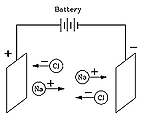|
Although at first this seemed like a strange idea, today it is quite well understood. Many chemical molecules are formed when atoms share electrons, but molecules such as those of NaCl are different. There, the sodium atom (Na) gives up an electron to the chlorine (Cl), creating ions Na+ and Cl-, which in solid salt are held together by their electric attraction. Water, however, greatly weakens that attraction (on a microscopic scale), allowing the ions to drift free whenever salt is dissolved in water, and allowing the water to conduct electricity.
Ions in a plasma
In plasma discharges in rarefied gases (like those in fluorescent tubes) ions are also produced. J.J. Thomson, who discovered the electron, later (1907-11) produced narrow beams of protons in a near-vacuum and studied their reaction to magnetic and electric forces.
Today, of course, proton beams are routinely produced and accelerated to very high energies, in huge machines like the "Tevatron" south of Chicago. Some of them are allowed to smash into targets, to study the structure of matter and produce a variety of "new" particles. Another "cleaner" mode of studying them is to cause a head-on collision between a beam of protons and another one of antiprotons, "antimatter" particles resembling protons but with a negative charge. The proton-antiproton collision is cleaner because it only involves two relatively simple particles, but the antiprotons must first be produced by some other high-energy collisions, since they do not usually exist in nature.
Ions emitted by radioactivity
|


 Official GSFC Home Page
Official GSFC Home Page  NASA WWW Home Page
NASA WWW Home Page